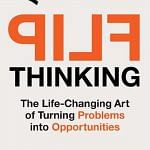In Raiders of the Lost Ark, the first film in Steven Spielberg’s Indiana Jones series, a scene was planned in which actor Harrison Ford, as Indy, has an intense swordfight with one of his many assailants. The fight was to be one of the film’s high[1]lights, and no fewer than three days were scheduled for filming it. In order to make the scene as convincing as possible, Ford had been practising his sword technique and the choreography for weeks. But on the first day scheduled for filming, Ford suffered a serious attack of diarrhoea and couldn’t do the fight. Fortunately, Ford had a great idea. He suggested to Spielberg that it might work better not to have the fight. When the menacing swordsman flourishes his massive blade, Indiana Jones just sighs, pulls out his gun and simply shoots his attacker. It is one of the classic scenes in motion picture history. Absolutely brilliant flip thinking!
The first, simplest, and most obvious – but at the same time perhaps the most difficult – strategy is that of acceptance. As the psychologist Carl Jung put it, ‘We cannot change anything unless we accept it. Condemnation does not liberate; it oppresses.’ The question at the heart of this strategy is: is there something I’m resisting that I would be better off accepting? The wind? Diarrhoea? My mood? As the Indiana Jones story illustrates so perfectly, once we stop resisting that which we can’t change, sometimes a new opportunity arises that we would never have seen if we’d kept resisting, if we had held on to how the situation ‘should be’.
The strategy of acceptance is the first of the 15 strategies for good reason. You could look at acceptance as the mother of all strategies. It’s the cornerstone of flip thinking; a foundation for all the other strategies. In many cases, simply accepting reality is all that’s needed to make a flip.
Also read: Was Ambedkar an avatar of God? A group of Mahar Sadhus thought so
But, of course, acceptance is easier said than done. It doesn’t just mean letting go of how you think the world should be; it also requires a certain frame of mind. As long as we are judging, fretting, evaluating, coming up with scenarios about what should be, we’re not accepting. Only by observing reality without such normative judgement can we truly accept it. As a fact. Observing reality in this way requires a particular state of mind best be described as ‘paying attention’. The essence of ‘paying attention’ is that you strive to be present and aware in the here and now, without judging, evaluating or trying to change reality as it is. There are no problems to be solved, worries to pay attention to or reflections on the past or future that draw out attention. You just are aware. No more, no less.
This kind of acceptance isn’t easy. That’s in part because acceptance has a bad reputation. We associate it with resignation and submission. As if it’s a form of weakness. And we prefer to be strong, self-assured and autonomous. We would prefer to shape reality rather than bend to it. Yet reality is infinitely stronger than any one of us. We are just a tiny part of an immense universe. Often we act as if that one tiny part can control the universe, but of course it doesn’t work like that. We are a fragile part of a larger whole.
Ironically, the illusion of control, of the power to fit reality to our design, makes us weaker. We fight hopeless battles, do our best to resist the inevitable, and often end up shutting ourselves off from possibilities we won’t entertain. Resistance doesn’t build our strength; it’s acceptance, and then adaptation, that make us stronger. Adaptation is a vital creative force. We must harness it and turn it to our advantage. Plants, animals, people, everything in nature has become what it is thanks to the phenomenal capacity of adaptation. The famous phrase ‘survival of the fittest’, coined by Herbert Spencer and adopted by Charles Darwin, is sometimes taken to mean ‘survival of the strongest’, but that wasn’t Darwin’s point. Those who are the fittest, he showed, are the ones that adapt best to challenges. Animals survive best by adjusting to meet the demands of their environment. As we saw earlier, nature is antifragile. Plants that grow in dry ground are the ones that develop the deepest roots. Adaptation leads to transformation.
 This excerpt from Berthold Gunster’s ‘Flip Thinking’ has been published with permission from Penguin Random House.
This excerpt from Berthold Gunster’s ‘Flip Thinking’ has been published with permission from Penguin Random House.






